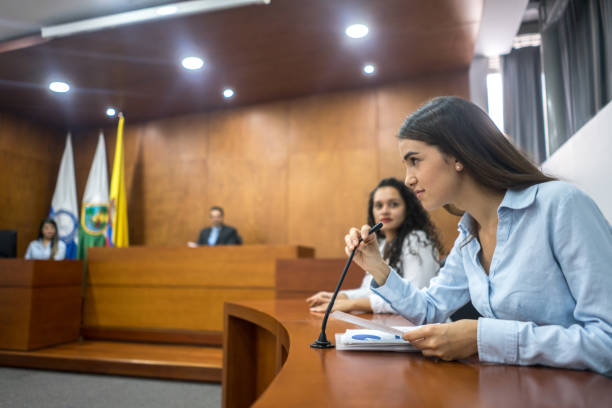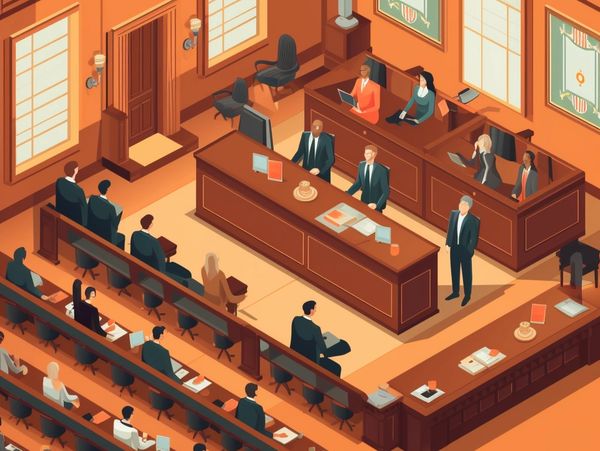Leading Techniques for Creating Impactful Trial Presentations in Courtroom Settings
Leading Techniques for Creating Impactful Trial Presentations in Courtroom Settings
Blog Article
Navigating the Intricacies of Trial Presentations: Tips for Seamless Shipment and Compelling Debates
In the world of lawful process, the art of trial presentation stands as a crucial factor of success. The complexities intrinsic in test discussions need a fragile equilibrium of ability, finesse, and method.

Understanding Trial Goals
To properly navigate a trial, it is essential to have a clear understanding of the goals that require to be attained. Prior to entering the courtroom, lawful groups need to specify their objectives and desired outcomes. These goals act as assisting concepts throughout the test, forming approaches and affecting decision-making procedures.
Understanding trial objectives involves an extensive analysis of the case, legal precedents, and the client's best interests. Trial Presentations. It requires a meticulous examination of the facts, recognizing key concerns, and preparing for possible obstacles. By establishing measurable and specific objectives, lawyers can customize their presentations and debates to straighten with the preferred results
Moreover, a clear grip of test goals allows legal groups to prioritize evidence, witnesses, and lawful disagreements efficiently. It allows for the growth of a systematic narrative that resonates with the court and jury, strengthening the total situation presentation.

Organizing Proof Efficiently
Having a clear understanding of trial purposes lays the foundation for organizing evidence effectively in lawful proceedings. By straightening the presentation of proof with the desired end results of the trial, lawful teams can reinforce their arguments and enhance their persuasiveness.
One more key aspect in arranging evidence properly is establishing a sensible flow. Providing evidence in a meaningful and sequential fashion can help develop an engaging narrative that supports the lawful arguments being made. Furthermore, making use of visual help such as charts, timelines, or graphs can further improve the company of evidence and assist in clearing up intricate relationships or sequences of occasions.
Furthermore, guaranteeing that all proof offered is admissible and relevant to the instance is vital. Unimportant or inadmissible proof can take away from the strength of the argument and potentially hurt the reputation of the presenting party. A precise testimonial and choice procedure should be carried out to include just the most impactful and legitimately sound evidence in the test discussion.
Crafting Influential Stories
Crafting compelling stories plays an essential role in offering persuasive debates during lawful procedures. When creating a story for a test presentation, it is essential to develop a clear storyline that highlights crucial points and links them in a coherent way. By weaving together evidence, testament, and legal debates into a natural and persuasive narrative, lawful professionals can successfully advocate for their clients and raise the likelihood of a positive outcome in the court.
Understanding Visual Aids
Reliable use of visual help is vital to enhancing the effect and quality important link of trial presentations. Aesthetic help, when made use of strategically, have the power to streamline intricate details, reinforce bottom lines, and leave a lasting impression on the judge and court. To understand aesthetic help in trial presentations, it is important to make certain that they are clear, succinct, and relevant to the arguments being made.
When integrating visual help, such as graphes, timelines, photographs, or graphs, into a trial presentation, it is vital to maintain them aesthetically appealing yet expert. The visuals must enhance the spoken debates, supplying a graph of the info being gone over without frustrating the target market with unnecessary details.
Furthermore, practicing with the visual help ahead of time is important to guarantee a seamless delivery throughout the test. Acquainting oneself with the material, transitions, and timings of each visual help can aid preserve the flow of the presentation and prevent technological problems that may emerge.
Providing Impactful Closing Debates
An engaging closing argument offers as the culmination of a test presentation, see it here enveloping the core story and convincing the court and jury in the direction of a favorable choice. Begin by outlining the primary debates that support your customer's position, highlighting why the proof presented throughout the trial sustains your narrative.
Moreover, incorporating emotional charm can additionally reinforce your closing debate. Inevitably, a well-crafted check my site closing debate need to leave a lasting impression, compelling the judge and jury to rule in your customer's support.
Conclusion
In conclusion, mastering trial discussions entails recognizing purposes, arranging proof, crafting stories, using visual aids, and delivering impactful closing arguments. By implementing these strategies effectively, lawyers can offer their instance flawlessly and make engaging disagreements in the court. It is essential to navigate the intricacies of test presentations with precision and ability to attain success in legal proceedings.
By aligning the discussion of proof with the desired outcomes of the test, legal teams can reinforce their debates and improve their persuasiveness (Trial Presentations). To master aesthetic help in trial presentations, it is critical to make sure that they are clear, concise, and relevant to the debates being made
A compelling closing argument offers as the conclusion of a test discussion, encapsulating the core story and convincing the court and jury towards a positive decision. Begin by laying out the primary arguments that sustain your client's placement, emphasizing why the proof provided throughout the test supports your story.In final thought, understanding trial discussions includes recognizing goals, arranging evidence, crafting stories, utilizing aesthetic aids, and providing impactful closing arguments.
Report this page